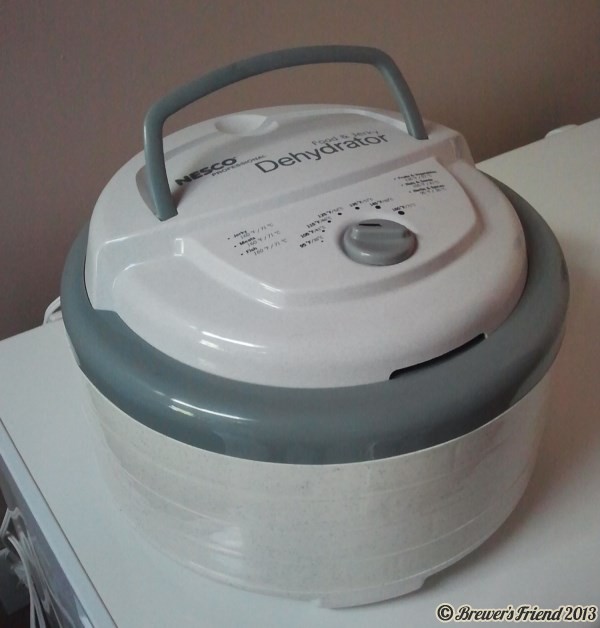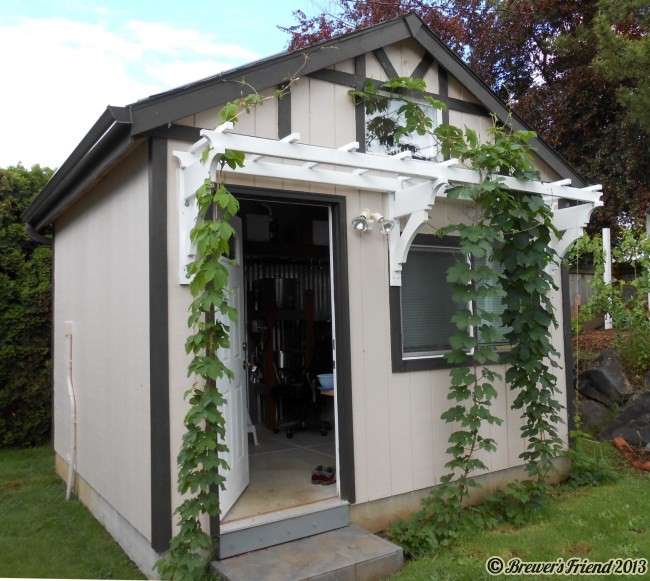Drying Hops Using a Food Dehydrator – Great Results
Friday, September 6th, 2013This year for drying my home grown hops I commandeered the household food dehydrator. It works like a charm. Makes the shed smell AMAZING!!!
In previous years I used a window screen and box fan but I don’t see myself going back to that. The window screen and fan approach can take days and days to finish drying. The dehydrator was done in 8-9 hours on the lowest setting of 95F (35C). This approach is faster and gives the hops a more uniform level of dryness.


Dry your hops at the right temperature:
At first I was worried a food dehydrator would be too intense in terms of heat and airflow on the delicate hop cones and essential oils.
After doing research about what temperature hops are dried at and double checking what temperature settings my food dehydrator had, there was no risk at all. The lowest temperature I found mentioning hop oil vaporization was 100F [1]. On professional scale, hops are kiln dried between 130F (54C) and 145F (63C). In the kiln they are layered up to 28″ high. The hops are then blended and dried for another 24-36 hours before being packaged [2]. Based on that, the 95F (35C) temperature sounded pretty safe.

How long to dry for?
Every few hours I checked the cones to see how dry they were. After 4 hours many were still damp when I squeezed them. After 8 hours all but one or two were completely dry. Right around 9 hours in the dehydrator was perfect for this year’s hops harvest.
Other DIY approaches:
As I mentioned above, the window screen drying approach works but takes time. If you have a lot of hops to harvest it starts taking up way too much space.
Braukaiser has a great article on building a hop drying oast, which is a DIY 2×4 frame with a box fan built into it. He says it takes about 3 days to dry the hops that way. He also points out that some essential hop oils actually vaporize at temperatures as low as 100F (40C). Drying the hops at cooler temperatures is beneficial.
How much can it hold?
This food dehydrator can fit a pound of wet hops comfortably. After drying the weight was about 6 ounces. This was from one Chinook plant that grows vigorously up the front of the shed.
How to store and inventory the hops?
After drying I vacuum seal the hops into 2oz packages and store in the freezer. I also update the My Inventory section of my Brewer’s Friend account. I put the AA level at the low end of the spectrum for the variety. Since I’m flying blind in terms of AA levels I’m conservative. Besides I generally use home grown hops for flavor or aroma additions only so the IBU impact is not that critical.
A fresh hop brew would have been another awesome way to use up a pound of wet Chinook hops, but alas all my kegs are full and the fermentation chamber is occupied with a lager right now. Not a bad problem to have.
Post by Larry
[1] Source: https://braukaiser.com/blog/blog/2012/12/09/hop-drying-at-home/
[2] Source: Hieronymus, Stan. For the Love of Hops : The Practical Guide to Aroma, Bitterness and the Culture of Hops. N.p.: Brewers Publications, 2012. Print.)






































